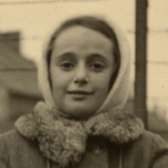
Katie Altenberg was born Käte Engel into a Jewish family in Vienna, Austria in 1936. She and her younger brother Adolph (Adi) lived with their parents on a large estate called Edmundshof in the Austrian province of Burgenland bordering Hungary. They had family in Austria, Czechoslovakia, and Hungary. Her father, Ludwig, an agronomist, leased land from the Heiligenkreuz Abbey (Stift Heiligenkreuz; Abbey of the Holy Cross) and built a general farm there. Her mother, Greta (née Stösller), who grew up in Vienna in an affluent family, reluctantly moved to the countryside.
In March 1938, Nazi Germany annexed Austria, an event known as the Anschluss. Shortly afterwards, the Gestapo arrested Ludwig. Due to Greta’s great perseverance and a lot of money, she succeeded in getting him released from prison. However, Ludwig had to leave the country immediately. He fled across the border into neighboring Hungary in a hay wagon. A short time later, the family joined him on an uncle’s estate in Hungary.
Hungary was an ally of Nazi Germany. The Hungarian government passed its own antisemitic laws beginning in 1938. As antisemitism worsened, the family tried to become invisible in the Hungarian village to no avail. When Hungary attempted to make a separate peace with the Allied Powers, Germany occupied the country in March 1944.
One night, the family was arrested and taken to the national prison in Budapest. Eventually they were transferred to the Hungarian-run Kistarcsa internment camp outside Budapest. One day an announcement was made that young children who had relatives in Budapest could be sent to them. Their parents decided to send Katie and Adi to their aunt, but instead they were taken to Budapest and detained along with other Jewish children.
Ludwig, who alternated between escaping Kistarcsa and being rearrested, found them in Budapest. He brought them to their aunt’s apartment to temporary safety. Her building was one of Raoul Wallenberg’s “protected houses.” However, in the fall of 1944, Katie, her father, brother, and aunt were forced to move into the Budapest ghetto.
The Soviets liberated the Budapest ghetto in early 1945. Katie and her family returned to her aunt’s apartment. Her father immediately started searching for her mother who they thought was in a labor camp. He ultimately found her in a terrible physical condition and brought her home.
Many members of Katie’s extended family did not survive the Holocaust. Her maternal grandfather Gustav Stösller was deported to Theresienstadt in 1942, where he died a year later.
Katie immigrated to the United States with her family in November 1948. She has two children and was a volunteer at the United States Holocaust Memorial Museum.











